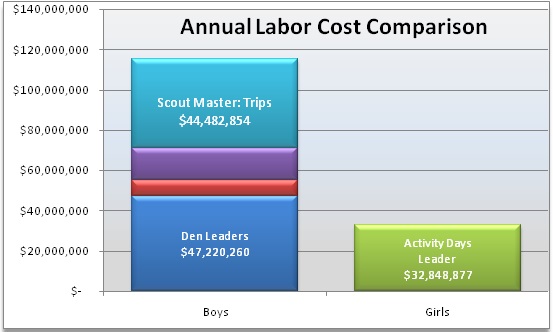Today’s guest post is by Nate Curtis, an endowed member with a current temple recommend. He is currently serving as the stake cub master in Phoenix, Arizona. Nate is an Eagle Scout and a forensic economist. In the past, he has served in bishoprics, as elders’ quorum president, seminary instructor, and as a temple worker.
For many economists, money is a standard measure for a unit of energy. Money is exchanged, with the expectation that an agreed-upon amount of energy be invested in creating an object or service.
The following analysis uses the common measure of money as energy to determine the expectation set by the church for energy expenditures on boys and girls from ages 8 to 18.
1. Hard Cost Comparison
As set forth in Chart 1, the Church expects members in the United States to collectively invest approximately $17,561,000 per year on scouting hard costs (ages 8-18). This cost is only for uniforms, awards, supplies and BSA registration. There is no equivalent investment for girls ages 8-18 in the LDS church.
2. Labor Cost Comparison
As set forth in Chart 2, the church expects its members to invest approximately $115.3 million annually in labor hours for the scouting program in the U.S compared to an expectation of only $32.8 million in labor hours annually for the equivalent Activity Days program.
3. Total Cost Comparison
By supporting the Boy Scouts of America and providing no equivalent program for girls, the LDS church expects members to spend approximately $100 million more on boys than girls annually.[1]
The Church Handbook of Instruction states, “Priesthood Leaders make every effort to ensure that the level of budget allocations and activities for the young men and young women organizations are equitable.”[2] However, this instruction to bishops and stake presidents is essentially impossible due to the inherent inequality of the church’s participation in the scouting program.
The Church can either stop scouting or start providing comparable programs for girls, but continuing the rhetoric of equality for our youth is neither honest nor sustainable.
[1]$82.46 million in annual labor disparity plus $17.56 million per year in scouting hard costs.
[2] Handbook 1 Stake Presidents and Bishops 2010, Section 14.7.2.
;
Facts and Assumptions
As with all economic analysis, the math is predicated on some combination of facts and assumptions. The following is a list of assumptions and facts supporting those assumptions. I will provide a copy of the model to anyone who would like to analyze this argument.
Assumptions:
- 4 Activity Days Leaders per ward
- 6 Den leaders per ward – 2 are required for any meeting that involve youth and there are 3 dens per ward.
- 1 Cub master per ward — required in order to register a Cub Scout pack with the BSA.
- 2 Scout masters per ward – 2 are required for any meetings that involve youth.
- 36 meeting hours per year – All scout leaders and Activity Day leaders attend approximately 4 meeting with thy youth for 9 months each year.
- 10 preparation hours per year – All scout leaders and Activity Day leaders spend, on average, the same amount of time preparing for their meetings with the youth.
- 130 Trip hours per year — Boy scout leaders are expected to supervise and attend 1 overnight trip per month except for Christmas. I excluded an additional month because summer camp and girls’ camp are excluded from this analysis. I assumed the average overnight trip takes 13 hours.
- 40% of U.S. Members are active.
- Bishoprics, primary presidencies, and youth presidencies spend roughly equal time on the Scouting and Young Women’s programs.
Facts:
- The church pays the Boy Scouts of America approximately $24 each year for every boy.
- Prices for these items were sourced to my local scout shop.
- There were 412,720 Mormon scouts in 2010
- There are 13,742 ward units in the United States
- The national average hourly wage for child care workers is $12.45 (Bureau of Labor Statistics — Occupational Employment Statistics, SOC Code 399011).
Exclusions:
- Labor hours for BSA training, committees, executive officers, charter organization representatives and adult registration fees because there are no clear time expectations set for these callings both in practice and in policy.
- Scout camp and girls’ camp labor hours and hard costs on the belief that those two events require comparable dollars and labor hours.
- Cost of seminary and mutual activities that benefit both genders.
;
[For the Equality is not a Feeling archive, click here.]


